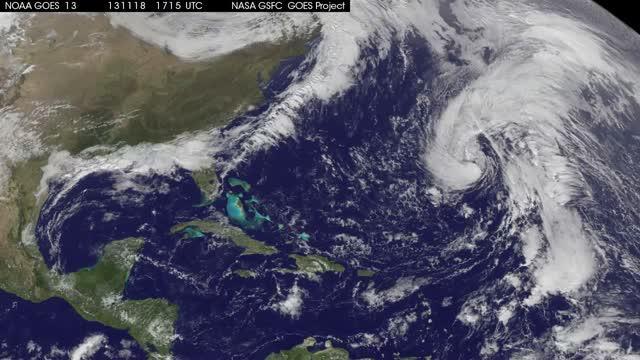(Edmonton) Scientists using a particle detector made of ice at the South Pole have found the first indication of high-energy neutrinos that originate outside of the solar system.
Heavens
For the first time, a team of astronomers from around the world, including experts from the University of Leicester, have used data from satellites and observatories to explain the brightest Gamma-ray Burst (GRB) ever recorded.
Neutrinos can zip right through your body, the walls of your house, entire planets, even emerging from near the surface of fascinating and frightening black holes.
And now, an international scientific collaboration that includes researchers from the University of Delaware has taken an 'astronomical' step forward in unmasking the origins of some of these high-energy particles, the so-called "messengers of the universe."
LOS ALAMOS, N.M., Nov. 21, 2013—Intelligent telescopes designed by Los Alamos National Laboratory got a front row seat recently for an unusual birth.
"Los Alamos' RAPTOR telescopes in New Mexico and Hawaii received a very bright cosmic birth announcement for a black hole on April 27," said astrophysicist Tom Vestrand, lead author of a paper appearing today in the journal Science that highlights the unusual event.
This news release is available in German.
A wide variety of particles perpetually pound onto the Earth's atmosphere. Most of these particles, like protons, electrons or helium nuclei have a certain mass and carry an electrical charge. When they collide with other particles or are deflected by the cosmic magnetic fields, the sun or the Earth, they alter their path and energy.
NASA's Aqua satellite captured visible and infrared imagery of slow-moving Tropical Storm Helen as it was spreading its western clouds over parts of southeastern India on November 21.
Melissa was centered near 40.0 north latitude and 34.8 west longitude, about 440 miles/710 kilometers west-northwest of the Azores. Melissa was moving to the east-northeast at a speedy 32 mph/52 kph and had a minimum central pressure near 984 millibars. The center of Melissa will pass north of the western Azores today, Nov. 21.
The National Hurricane Center expects Melissa to become post-tropical later today. Gradual weakening is forecast during the next two days.

Astronomers using the combined power of the Atacama Large Millimeter/submillimeter Array (ALMA) telescope and NASA's Hubble Space Telescope have discovered a far-flung trio of primitive galaxies nestled inside an enormous blob of primordial gas nearly 13 billion light-years from Earth.
Researchers at the Ruhr-Universität Bochum (RUB) have developed a bio-based solar cell. They embedded the two proteins photosystem 1 and 2, which in plants are responsible of photosynthesis, into complex molecules developed in-house, thus creating an efficient electron current. Headed by Prof Dr Wolfgang Schuhmann from the Department of Analytical Chemistry and Center for Electrochemical Sciences (CES) and Prof Dr Matthias Rögner from the Department of Plant Biochemistry, the team has published a report in the journal "Angewandte Chemie".
Researchers at the USC Viterbi School of Engineering have developed a faster 3D printing process and are now using it to model and fabricate heterogeneous objects, which comprise multiple materials.
Astronomers have long sought strong evidence that Sagittarius A* (Sgr A*), the supermassive black hole at the center of the Milky Way, is producing a jet of high-energy particles. Finally they have found it, in new results from NASA's Chandra X-ray Observatory and the National Science Foundation's Very Large Array (VLA) radio telescope.
Previous studies, using a variety of telescopes, suggested there was a jet, but these reports -- including the orientation of the suspected jets -- often contradicted each other and were not considered definitive.
TRMM Precipitation Radar data were also used to create a 3-D image that showed Melissa's structure. The TRMM data revealed that the tallest towers, reaching heights of over 13km/~8 miles, were located in a band of rainfall to the northwest of Melissa's center. The strongest intensity radar echo of over 49dBZ was returned from an area of heavy convective storms near Melissa's center. This heavy convection near the center signaled Melissa's transition from a subtropical storm to a tropical storm.
Washington, D.C. -- When Neil Armstrong took humanity's first otherworldly steps in 1969, he didn't know what a nuisance the lunar soil beneath his feet would prove to be. The scratchy dust clung to everything it touched, causing scientific instruments to overheat and, for Apollo 17 astronaut Harrison Schmitt, a sort of lunar dust hay fever. The annoying particles even prompted a scientific experiment to figure out how fast they collect, but NASA's data got lost.
Tropical Cyclone 04B has strengthened and been renamed "Helen" as it slowly nears landfall in southeastern India.
TALLAHASSEE, Fla. - As NASA prepares to launch a new Martian probe, a Florida State University scientist has uncovered what may be the first recognized example of ancient Martian crust.